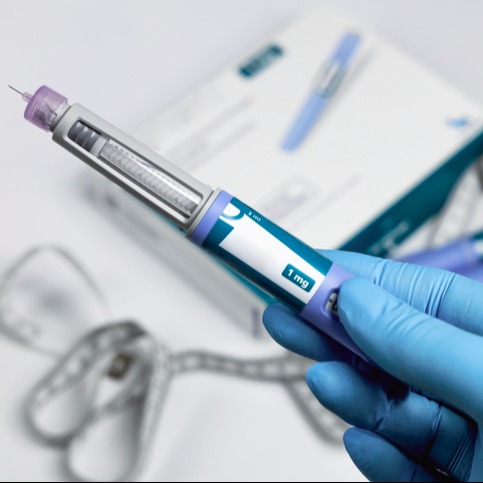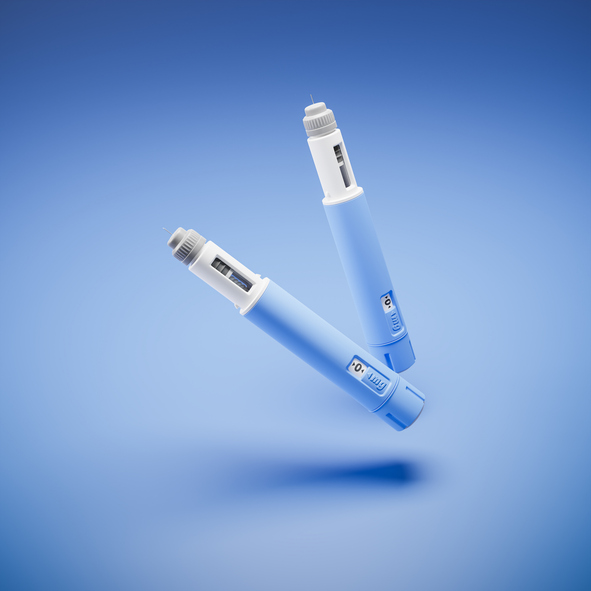
Medications traditionally used to manage blood glucose levels, like Ozempic, have come to the forefront recently for individuals seeking to lose body weight. Over time, it has become increasingly apparent that the class of medications called glucagon-like peptide-1 (GLP-1) agonists is not only helpful for lowering diabetes markers like A1c but also shows significant weight loss.
As interest in medications like Ozempic grows, some barriers have become more apparent for many. It’s essential to ensure these medications are used safely, as they have important warnings. Some individuals may prefer not to use an injection. They are also expensive and not always readily available, leading many to research alternatives.
In this article, we’ll review some of the similarities and differences between Ozempic and Rybelsus, an alternative GLP-1 medication that offers dosing in the form of oral tablets.
Key Takeaways:
Both Rybelsus and Ozempic provide the same active ingredient, semaglutide.
Both medications have improved blood glucose control in individuals managing type 2 diabetes.
Ozempic has additional FDA approval specifically for lowering the risk of cardiovascular events like heart attack or stroke in patients managing type 2 diabetes.
Neither Rybelsus nor Ozempic has been specifically approved for weight loss. However, the active ingredient semaglutide is used at a higher dose in Wegovy, which is approved for weight loss. The lower doses of semaglutide provided by Rybelsus and Ozempic have also been associated with significant weight loss. Weight loss is generally expected to be more significant with the available strengths of the injectable forms.
The side effects of both Rybelsus and Ozempic are largely gastrointestinal. An upset stomach is common.
Discussing your medical history with your providers is critical to ensure the safe use of these medications. Both Rybelsus and Ozempic are associated with higher rates of pancreatitis and thyroid tumors. If you have a personal history of pancreatitis or if you or a family member have a history of thyroid tumors, these medications may not be appropriate to use.
Rybelsus and Ozempic Uses
Rybelsus and Ozempic share the same active ingredient, semaglutide. Semaglutide is a GLP-1 agonist, meaning it acts similarly to glucagon at particular receptors in the body. By mimicking glucagon, semaglutide helps regulate insulin secretion in the pancreas which helps improve blood sugar control. GLP-1 agonists also slow down stomach emptying and can reduce hunger.
Many GLP-1 medications have been associated with significant weight loss, generating a lot of interest over time. There are currently three forms of semaglutide available:
Ozempic, dosed up to 2 mg, injectable
Wegovy, dosed up to 2.4 mg, injectable
Rybelsus, dosed up to 14 mg, oral tablets
Rybelsus tablets are more subject to variability in absorption. While Rybelsus does show some modest weight loss benefits, they appear to be less significant than those provided by the injectable forms of semaglutide.
It’s important to remember that when semaglutide has been studied or ultimately recommended for weight loss, it has been intended for those who have:
A body mass index (BMI) of 30 kg/m2 or higher
A BMI of 27 kg/m2 AND at least one of the following:
High blood pressure
High cholesterol
Type 2 Diabetes
Obstructive sleep apnea
A history of cardiovascular disease
Rybelsus Uses
Rybelsus is a relatively new GLP-1 agonist medication. It is the only drug in the class that can be taken by mouth rather than using an injection. Particularly for those with an aversion to needles, it may represent an excellent option for additional support. Rybelsus has been studied in patients with type 2 diabetes to improve blood sugar control. Improved blood sugar control can ultimately lower the risk of developing complications like nerve pain, kidney disease, changes in vision, and cardiovascular disease.
Rybelsus has not been studied head-to-head with Ozempic in major trials, but it has been compared directly with another injectable GLP-1 medication called Victoza (liraglutide). A1c is a primary indicator of blood glucose control over time, and Rybelsus was as effective, if not slightly more effective, than Victoza in helping patients achieve their A1c goals.
Individuals considering Rybelsus for weight loss benefits should be aware of some of the functional differences in dosing between forms of semaglutide. Rybelsus dosing currently provides activity that could be considered roughly equivalent to the 0.5 mg dose of Ozempic, which is lower than the standard target doses of the injectable forms. For reference, Wegovy provides up to 2.4 mg of semaglutide for the specific purpose of weight loss. However, Rybelsus shows modest weight loss with 14 mg doses, resulting in a loss of around 3.8% of body mass.
Ozempic Uses
Ozempic has become well-established in the management of type 2 diabetes. Patients using the medication have been more able to reach A1c goals and may also have a lower risk of developing cardiovascular disease.
When considering Ozempic for weight loss, it’s important to be aware of the dosing differences between Ozempic and Wegovy, the form of semaglutide approved for weight loss. In trials, a 2.4 mg dose of semaglutide was used to achieve an average weight loss of about 15% of body mass over 68 weeks. The maximum available dose of Ozempic is slightly lower, at 2 mg. Lower doses of semaglutide have also been associated with significant weight loss.
Notably, the functional doses of semaglutide provided by an injectable like Ozempic can vary compared to oral tablets like Rybelsus. Different amounts of the medication are absorbed and are ultimately active. Even though the doses of Rybelsus appear higher, they cannot be compared directly because of these differences in absorption.
For instance, when switching from Rybelsus to Ozempic, the manufacturer notes that 14 mg of Rybelsus should be switched to 0.5 mg of Ozempic, and no dose of Rybelsus currently available is considered equivalent to 1 mg of Ozempic or higher. The injectable form (Ozempic) is expected to contribute to increased activity in the body for each milligram used.
Rybelsus and Ozempic Side Effects
Rybelsus and Ozempic can cause food to remain in the stomach for longer periods. This can impact hunger and body weight while also increasing the likelihood of experiencing gastrointestinal side effects.
These gastrointestinal side effects are systemic, meaning they can occur whether the medication is taken by mouth or injected. In many cases, these side effects may cause individuals to stop using these medications or continue at lower doses. These can be improved or avoided by gradually increasing the strength of each medication over several weeks or month-long increments to allow the body to adjust.
A primary potential difference between Rybelsus and Ozempic is the potential for injection site pain or reactions associated with Ozempic.
Rybelsus Side Effects
The most common side effects of Rybelsus reported by clinical trial participants included:
Nausea
Abdominal pain
Diarrhea
Reduced appetite
Vomiting
Constipation
It’s important to discuss your medical history with your healthcare providers to ensure the medication will be safe. There are several important factors to consider before starting any GLP-1 medication, including Rybelsus:
Gastroparesis is a condition characterized by delayed stomach emptying. Rybelsus and other GLP-1 medications can contribute to these symptoms and make existing gastroparesis worse.
Thyroid tumor development can be made more likely by using GLP-1 medications like Rybelsus. It’s important to talk with your healthcare provider about any personal or family history of thyroid tumors.
Pancreatitis rates appear to be higher in patients using GLP-1 medications. If you have a previous history of pancreatitis, your healthcare provider may recommend avoiding medications like Rybelsus.
Dehydration and subsequent kidney damage can occur if side effects like vomiting or diarrhea are not adequately managed. These result in fluid loss and electrolyte imbalances that can cause serious complications.
Ozempic Side Effects
The most common side effects reported with Ozempic include:
Nausea
Vomiting
Diarrhea
Abdominal pain
Constipation
The more general warnings related to gastroparesis, dehydration and kidney function, thyroid tumors, and pancreatitis also apply to Ozempic and other GLP-1 medications. Before starting new medications, it’s critical to have a full conversation with your healthcare provider about your medical history.
Rybelsus and Ozempic Cost
It’s important to consider both the benefits and risks of these medications with a healthcare provider. If you determine one of them may be right for you, it’s time to get your prescription filled at a pharmacy. Unfortunately, this process can be complex.
It may be helpful to call your insurance company first, as coverage can become complicated. These medications are expensive, with cash prices of well over $1,000 per month in the United States. They may ultimately not be covered for the reason you and your provider have decided to use them. Weight loss, for instance, is not an FDA-approved indication for Rybelsus or Ozempic, making prior authorizations and denials more common. Even if a prescription is covered, the out-of-pocket expenses can mount quickly, particularly if you have a high deductible plan. Pharmacies offer a wide range of prices for the same products, and your cost can vary greatly depending on where you choose to go.
Of course, this leads many to wonder how to get Ozempic or Rybelsus at reasonable prices. Pricing is becoming more transparent over time, and taking the time to research the prices at different pharmacies can save you a significant amount of money. Many also use Canadian pharmacies to fill personal prescriptions and take advantage of lower prices. PlanetDrugsDirect is a referral service that works with licensed Canadian pharmacies to help you find the medications you need. Many medications like Ozempic and Rybelsus can be found at lower rates, particularly for those with high deductibles or without insurance coverage.
Rybelsus Cost
In the United States, the standard cash price of Rybelsus is about $1,000 monthly. Out-of-pocket costs can vary broadly depending on insurance coverage and the pharmacy filling the prescription. The time it takes to research pricing at multiple pharmacies is often well worth it, as you may be able to save a significant amount of money.
Ozempic Cost
The usual cost of Ozempic at pharmacies in the US is also approximately $1,000 per month, varying according to the required dosage. Like Rybelsus, your expenses may vary significantly based on your insurance coverage and the pharmacy you select. You might find substantial savings of 20% or higher.
Conclusion
Rybelsus and Ozempic both contain the active ingredient semaglutide. Rybelsus is unique, as it is the only GLP-1 medication that can be taken as an oral tablet rather than an injection. Both medications are effective for improving blood glucose control in type 2 diabetes, but injectable forms of semaglutide are often associated with more substantial weight loss. The side effects and warnings are largely the same.
These medications are expensive, which can be a sizable barrier for many. Costs do vary between pharmacies, so it’s important to take the time to ensure you are getting a fair price.
Rely on PlanetDrugsDirect.com to Buy your Ozempic (Semaglutide)
As a trusted prescription referral service, we offer important benefits whenever you order online. Each of our partner pharmacies and/or government-approved dispensaries is committed to providing the best experience possible of any online prescription referral service on the internet. We offer:
Low prices
Quick turn-around times
Generic and brand-name medications
Unparalleled customer service
Sources
DailyMed. (n.d.). Drug label information. Retrieved from https://dailymed.nlm.nih.gov/dailymed/drugInfo.cfm?setid=27f15fac-7d98-4114-a2ec-92494a91da98
DailyMed. (n.d.). OZEMPIC- semaglutide injection, solution. Retrieved from https://dailymed.nlm.nih.gov/dailymed/drugInfo.cfm?setid=adec4fd2-6858-4c99-91d4-531f5f2a2d79
Pietiläinen, K. H., Rissanen, A., Laamanen, M., Sovijärvi, A., Yki-Järvinen, H., Kaprio, J., & Rissanen, A. (2011). Growth patterns in young adult monozygotic twin pairs discordant and concordant for obesity. Twin Research and Human Genetics, 14(6), 490-498. https://doi.org/10.1375/twin.14.6.490
McMurray, J. J. V., Packer, M., Desai, A. S., Gong, J., Lefkowitz, M. P., Rizkala, A. R., ... & Zile, M. R. (2016). Angiotensin–neprilysin inhibition versus enalapril in heart failure. The New England Journal of Medicine, 371(11), 993-1004. https://doi.org/10.1056/NEJMoa1607141
 Medically reviewed by
Medically reviewed by 





